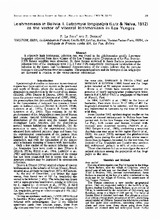Mostrar el registro sencillo del ítem
Leishmaniasis in Bolivia. I. Lutzomyia longipalpis (Lutz & Neiva, 1912) as the vector of visceral leishmaniasis in los Yungas
| dc.contributor.author | Le Pont, F | |
| dc.contributor.author | Desjeux, P | |
| dc.date.accessioned | 2017-05-05T13:39:37Z | |
| dc.date.available | 2017-05-05T13:39:37Z | |
| dc.date.issued | 1985 | |
| dc.identifier.uri | http://repositorio.umsa.bo/xmlui/handle/123456789/10349 | |
| dc.description.abstract | Abstract. A relatively high leishmanial infection rate was found in the phlebotomine sandfly Lutzomyia longipalpis collected from three villages of the Los Yungas region (Department of La Paz, Bolivia). 2,578 female sandfties were dissected. In three houses surveyed in Santa Barbara promastigote infection rates of Lu. longipalpis were 4•2, 2•2 and 3•2% respectively. Anatomical localization of the infection in the insect, and biochemical characterization of the strains indicate that the parasite belongs to the Leishmania donovani complex. The geographical area and the biotopes of Lu. longipalpis are discussed in relation to the vector-parasite relationship. | es_ES |
| dc.language.iso | en | es_ES |
| dc.publisher | Transantions of The Royal Society of Tropical Medicine and Hygiene | es_ES |
| dc.subject | LEISHMANIASIS EN BOLIVIA | es_ES |
| dc.subject | LEISHMANIASIS EN LOS YUNGAS | es_ES |
| dc.subject | LUTZOMYIA LONGIPALPIS | es_ES |
| dc.title | Leishmaniasis in Bolivia. I. Lutzomyia longipalpis (Lutz & Neiva, 1912) as the vector of visceral leishmaniasis in los Yungas | es_ES |
| dc.type | Article | es_ES |

